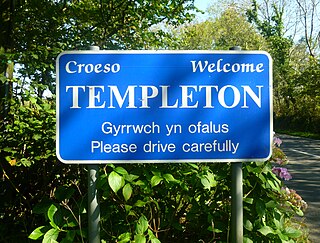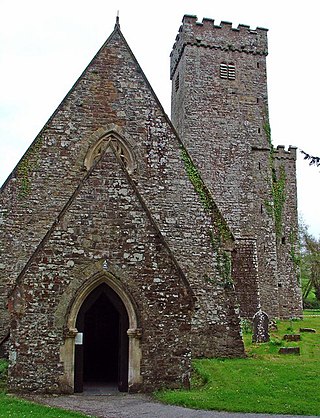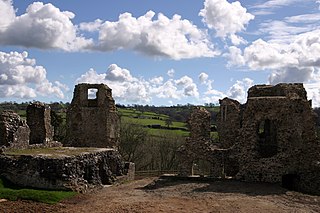
Pembroke is a town and community in Pembrokeshire, Wales, with a population of 7,552. The names of both the town and the county have a common origin; both are derived from the Cantref of Penfro: Pen, 'head' or 'end', and bro, 'region', 'country', 'land', which has been interpreted to mean either 'Land's End' or 'headland'.

Tenby is a seaside town and community in the county of Pembrokeshire, Wales. It lies within Carmarthen Bay.

Narberth is a town and community in Pembrokeshire, Wales. It was founded around a Welsh court and later became a Norman stronghold on the Landsker Line. It became the headquarters of the hundred of Narberth. It was once a marcher borough. George Owen described it in 1603 as one of nine Pembrokeshire "boroughs in decay".

Picton Castle is a medieval castle near Haverfordwest in the community of Uzmaston, Boulston and Slebech, Pembrokeshire, Wales. Originally built at the end of the 13th century by a Flemish knight, it later came into the hands of Sir John Wogan. The castle and gardens are now owned and managed by the Picton Castle Trust, a registered charity, for the benefit of the public. It is of unusual construction and has been remodelled several times during its history. The castle is a Grade I listed building and its gardens and park are designated at Grade II* on the Cadw/ICOMOS Register of Parks and Gardens of Special Historic Interest in Wales.

John Campbell, 1st Baron Cawdor, FRS, FSA was a British politician, military officer and peer who sat in the House of Commons of Great Britain from 1777 to 1796.

Oakley Court is a Victorian Gothic country house set in 35 acres (140,000 m2) overlooking the River Thames at Water Oakley in the civil parish of Bray in the English county of Berkshire. It was built in 1859 and is currently a hotel. It is a Grade II* listed building that has been often used as a film location.

Templeton is a village and community in Pembrokeshire, Wales. The population of the community was 943 in 2011. The built-up area had a population of 627.

Llawhaden is a village, parish and community in mid-Pembrokeshire, West Wales, historically in the Hundred of Dungleddy. The community of Llawhaden includes the parish of Robeston Wathen, part of Narberth and the hamlet of Gelli, and had a population of 634 in 2001, increasing to 688 at the 2011 Census.

Major General Rowland Laugharne was a member of the Welsh gentry, and a prominent soldier during the Wars of the Three Kingdoms, in which he fought on both sides.

Richard Vaughan, 2nd Earl of Carbery KB, PC, styled The Honourable from 1621 to 1628 and then Lord Vaughan until 1634, was a Welsh soldier, peer and politician.

Narberth Castle is a ruined Norman fortress in the town of Narberth, Pembrokeshire, West Wales. It forms part of the Landsker Line.
This is a list of High Sheriffs of Pembrokeshire. The High Sheriff is the oldest secular office under the Crown. Formerly the High Sheriff was the principal law enforcement officer in the county but over the centuries most of the responsibilities associated with the post have been transferred elsewhere or are now defunct, so that its functions are now largely ceremonial. The High Sheriff is reappointed in March of each year.
Rice Powell was a Welsh Colonel in the Parliamentary army during the First English Civil War. In the Second English Civil War he allied himself with the Royalist cause. He fought in South Wales and played a significant part in events between 1642 and 1649 including a senior role during the Battle of St. Fagans.
Sir Hugh Owen, 1st Baronet was a Welsh politician who sat in the House of Commons variously between 1626 and 1660. He sided originally with the Parliamentarian side in the English Civil War, but the strength of his allegiance was in doubt.
The office of High Sheriff of Dyfed was established in 1974 as part of the creation of the county of Dyfed in Wales following the Local Government Act 1972, and effectively replaced the shrievalties of the amalgamated counties of Cardiganshire, Carmarthenshire and Pembrokeshire. Since 1996 Dyfed has a purely ceremonial meaning, having been broken up for administrative purposes.

The Big House, also known as Landshipping House, is a historic house on the banks of the River Cleddau in Landshipping, Pembrokeshire, Wales.

Llanddewi Velfrey or Llandewi Velfrey is a village, parish and community of Pembrokeshire in West Wales. Historically it was in the Narberth Hundred. The village is in Lampeter Vale, 2 miles (3 km) northeast of Narberth along the A40. In 1831 it had a population of 710 people. In 2011 the population was 393.
Rocklands House near Goodrich, Herefordshire, England, is a building of historical significance and is Grade II listed on the English Heritage Register. It was built in the 1700s, and substantial additions were made in 1800. It was the home of many notable people over the next two centuries.
The Grove is a country house hotel near Narberth, Pembrokeshire, Wales. The 18th century building is Grade II listed. In 2015 it won the Welsh Hotel of the Year award and entered The Good Hotel Guide 2016.













